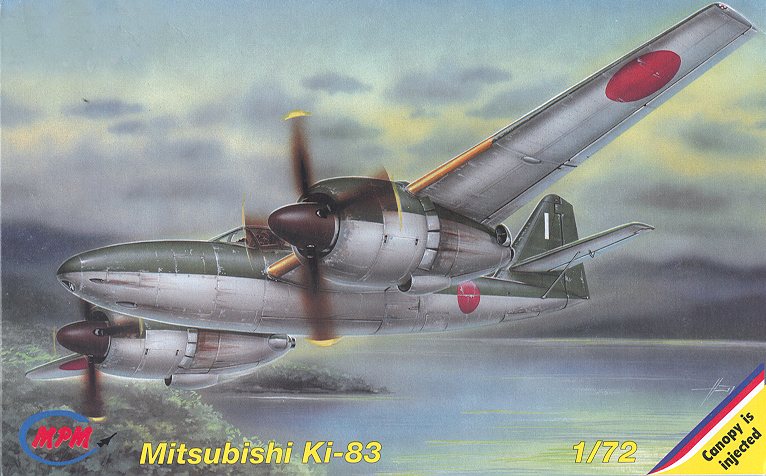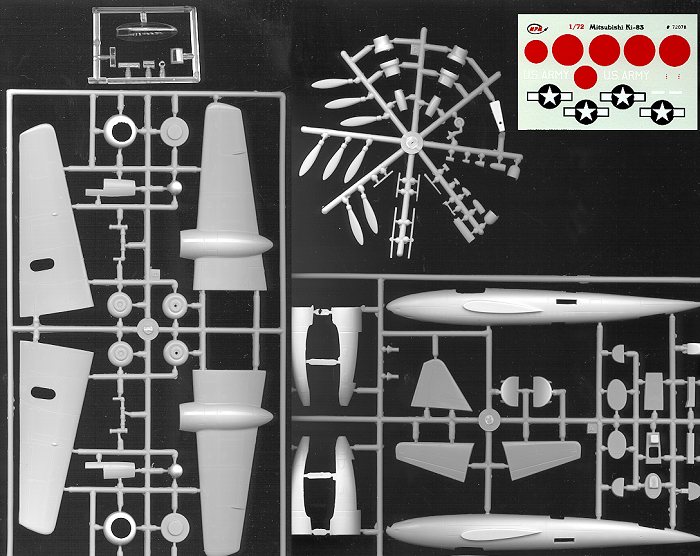
|
KIT: |
MPM 1/72 Ki-83 |
|
KIT # |
72088 |
|
PRICE: |
$20.98 |
|
DECALS: |
Two aircraft; see review |
|
REVIEW & |
|
|
NOTES: |
Short run-type kit |

|
HISTORY |
The Ki-83 was built to meet the requirements for a long-range escort fighter. The design team first tried a single engine design, the Ki-73. However, in light of severe problems plaguing the engine of choice, decided that it needed two engines to properly perform its design functions. The design team was the same that worked on the Ki-46, which accounts for some similarity between the two.
The new design was exceptionally clean and designed around two 2,200 hp Mitsubishi Ha-203-II 18 cylinder turbosupercharged radial engines. It was armed with two 30mm and two 20mm cannon. The initial prototype was completed in late 1944 with first flight in November of that year. The aircraft exceeded all expectations and was not only quite fast (426 mph) but very maneuverable as well. As one would expect, all was not perfect and the airframe suffered from engine and tail vibrations. The other three prototypes were produced with modified engine mounts and strengthened tail surfaces.
Unfortunately for the Ki-83, only the four prototypes were completed as production had to concentrate on existing types. Has the war continued, the Ki-83 would have been a formidable weapon with performance on par with the F7F and DH.103 Hornet.
|
THE KIT |

When this kit arrived in the mail, I was both excited and concerned. First of all, I have been on a 1/72 twin engined aircraft kick over the last few months, building types like the Ki-45, Ki-67 and Beaufighter. This kit would fit right in with the other Japanese twins. However, I have not had that much success with MPM kits. To be honest, my limited experience was with the very early MPM models and Czech kits have improved a great deal since then.
Take this kit for instance. The detailing is very good and more pronounced than on earlier kits. The sprue gates are also much smaller, though I would still use a razor saw to remove the parts. There is also a lot less flash on this kit than I have seen in the past, making clean-up much easier. In fact there is darn little flash and the mold lines are quite small as well. There are no ejector pin marks on any of the smaller parts and those on the larger bits (wings, fuselage) are easy to remove.
Cockpit detail is sufficient for this scale, the only real detail being on the instrument panel. There is none on the side consoles or the fuselage interior. Wheel well detail is also acceptable, though minimal as well. Typical of a short run kit, there are no locator pins on any parts, and the wings, tail and stabilizers are all butt joined. Thankfully missing from the kit are any etched metal or vacuformed parts. For that I am truly grateful as I feel these items add little to my modeling experience! The clear parts are not too thick and are reasonably clear. The canopy is in the closed position only.
Since this aircraft was only built as a prototype, decals are minimal. There are two aircraft given; the first prototype and the same aircraft as captured by the USAAF. Both are in dark green upper and light grey lower surfaces with yellow IFF bands on the leading edges of the wings. The American scheme is listed as USAF, which, as we know, wasn't around in 1945. A bit of a yuk. :o)
Instructions have 9 construction steps along with a short history and a color reference chart. All colors given are Humbrol and those items needing painting during construction are shown. The color chart gives generic names for the colors but is adequate.
Overall, it doesn't look like a bad kit and anyone with some experience in short run kits should have no trouble with this one. This would be a great chance for someone to do a JNAF '46 aircraft.
If you would like your product reviewed fairly and quickly by a site that has over 1,300 visits a day, please contact me or see other details in the Note to Contributors.